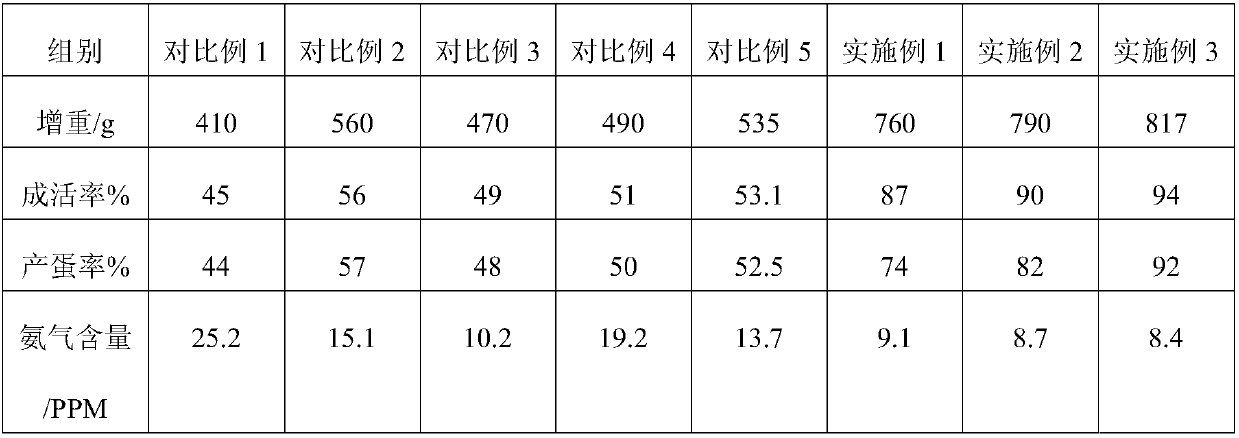Plant-derived feed, and preparation method and application method thereof
A plant source and feed technology, applied in animal feed, animal feed, applications, etc., can solve problems such as restrictions on the use of antibiotics, food safety, and environmental pollution
- Summary
- Abstract
- Description
- Claims
- Application Information
AI Technical Summary
Problems solved by technology
Method used
Image
Examples
Embodiment 1
[0039] A plant source feed, mainly made of the following raw materials in parts by weight: 15 parts of sage, 15 parts of sage, 11 parts of coriander, 13 parts of marjoram, 12 parts of radish, 8 parts of yucca, and 7 parts of a bunch of red , 9 parts of okra leaves, 4 parts of ginkgo leaves, 4 parts of red yeast rice, 5 parts of locust tree leaves, 3 parts of junipers, 4 parts of bearberry leaves, 3 parts of thistles, 5 parts of betaine, 4 parts of allicin, and 3 parts of organic acids 1 part, 1 part of flavor enhancer and 0.5 part of microorganism;
[0040] Among them, the flavor enhancer is composed of one or more of methylcyclopentenolone, styroyl acetate, benzyl benzoate and glyceryl butyrate; the microorganism is composed of yeast, bifidobacterium , mold and actinomycetes; the organic acid is composed of one or more of butyric acid, fumaric acid and lactic acid.
[0041] The above ratio is expected to use the following method to prepare plant-derived feed, specifically in...
Embodiment 2
[0050] A plant source feed, mainly made of the following raw materials in parts by weight: 16 parts of sage, 16 parts of sage, 11.5 parts of coriander, 14 parts of marjoram, 12.5 parts of radish, 9 parts of yucca, 7.5 parts of a string of red , 9.5 parts of okra leaf, 4.5 parts of ginkgo leaf, 5 parts of red yeast rice, 5.5 parts of locust tree leaf, 4 parts of juniper, 4.5 parts of bearberry leaf, 3.5 parts of thistle, 6 parts of betaine, 4.5 parts of allicin, 4 parts of organic acid 1.5 parts of flavor enhancer and 0.6 parts of microorganisms;
[0051] Among them, the flavor enhancer is composed of one or more of methylcyclopentenolone, styroyl acetate, benzyl benzoate and glyceryl butyrate; the microorganism is composed of yeast, bifidobacterium , mold and actinomycetes; the organic acid is composed of one or more of butyric acid, fumaric acid and lactic acid.
[0052] The above ratio is expected to use the following method to prepare plant-derived feed, specifically inclu...
Embodiment 3
[0061] A plant-source feed, mainly made of the following raw materials in parts by weight: 17 parts of sage, 17 parts of antidysentery, 12 parts of coriander, 15 parts of marjoram, 13 parts of radish, 10 parts of yucca, and 8 parts of a bunch of red , 10 parts of okra leaves, 5 parts of ginkgo leaves, 6 parts of red yeast rice, 6 parts of locust tree leaves, 5 parts of junipers, 5 parts of bearberry leaves, 4 parts of thistles, 7 parts of betaine, 5 parts of allicin, and 5 parts of organic acids 2 parts, 2 parts of flavor enhancer and 0.7 parts of microorganisms;
[0062] Among them, the flavor enhancer is composed of one or more of methylcyclopentenolone, styroyl acetate, benzyl benzoate and glyceryl butyrate; the microorganism is composed of yeast, bifidobacterium , mold and actinomycetes; the organic acid is composed of one or more of butyric acid, fumaric acid and lactic acid.
[0063] The above ratio is expected to use the following method to prepare plant-derived feed, ...
PUM
 Login to View More
Login to View More Abstract
Description
Claims
Application Information
 Login to View More
Login to View More - R&D
- Intellectual Property
- Life Sciences
- Materials
- Tech Scout
- Unparalleled Data Quality
- Higher Quality Content
- 60% Fewer Hallucinations
Browse by: Latest US Patents, China's latest patents, Technical Efficacy Thesaurus, Application Domain, Technology Topic, Popular Technical Reports.
© 2025 PatSnap. All rights reserved.Legal|Privacy policy|Modern Slavery Act Transparency Statement|Sitemap|About US| Contact US: help@patsnap.com

